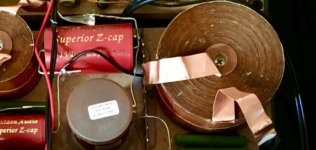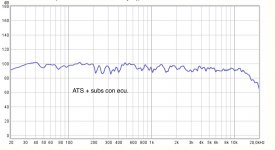Hello, I have Troels Gravensen loudspeakers, specifically the Jensen ATS model. Jenzen-ATS
Made some changes such as improving or, if you prefer, adjusting to my sound tastes, various caps of the crossover. Seeing the changes that choosing one cap or another can generate, especially those dedicated to high frequencies, I wonder if this is also important in the choice of coils. The cut-off on the ATS is at 2200 hz. Therefore, there is an important area of high frequencies that correspond to the mids speaker. The ATS works with a second order filter and uses a Jantzen model WAX 1.8mH, 0.37omh and 14 AWG coil in the mids section. My question is the following. Could you improve the sound by replacing this coil(respecting the original values)? If the answer is "yes", what makes and models can be suggested?
BR
Toñi
Made some changes such as improving or, if you prefer, adjusting to my sound tastes, various caps of the crossover. Seeing the changes that choosing one cap or another can generate, especially those dedicated to high frequencies, I wonder if this is also important in the choice of coils. The cut-off on the ATS is at 2200 hz. Therefore, there is an important area of high frequencies that correspond to the mids speaker. The ATS works with a second order filter and uses a Jantzen model WAX 1.8mH, 0.37omh and 14 AWG coil in the mids section. My question is the following. Could you improve the sound by replacing this coil(respecting the original values)? If the answer is "yes", what makes and models can be suggested?
BR
Toñi
If by respecting the original values you mean maintaining the DC resistance of 0.37ohm, which will have been factored into the original crossover design, then I don't see that your inductor can be bettered.
The AWG dictates the resistance of the coil. Making a coil with thicker wire will, of course, reduce the resistance. This reduction will alter the sound, but not necessarily for the better.
The AWG dictates the resistance of the coil. Making a coil with thicker wire will, of course, reduce the resistance. This reduction will alter the sound, but not necessarily for the better.
Don't change the nominal inductance and DCR values to make sure the xover still works as intended.
That said, different inductor types can make a small sonic difference. Air coils will have less non-linear distortion than a coil with a magnetic core that will saturate at some point. Also, mechanically stable coils will cause less non-linear distortion (resin impregnated coils ans similar). Finally, there are foil type inductors that are mechanically stable and may also have less skin effect (don't ask me to provide proof for this).
That said, different inductor types can make a small sonic difference. Air coils will have less non-linear distortion than a coil with a magnetic core that will saturate at some point. Also, mechanically stable coils will cause less non-linear distortion (resin impregnated coils ans similar). Finally, there are foil type inductors that are mechanically stable and may also have less skin effect (don't ask me to provide proof for this).
Hello, thanks for your help and opinions. As I had commented in the first message, i started from the idea of respecting all the original values of the coil. The point is that I have found that both the caps and the resistors generate obvious changes in the sound of the loudspeakers (with the same values). Therefore, I thought that the same happens with coils. Specifically, the one used is an air core and ribbon coil. As is known, Troels is limited to a single brand to make his designs. This does not mean that it is the best or the one that others like. Hence my idea to investigate other possibilities. I understand that from your experience it seems that great improvements cannot be expected by changing coils.
BR
Toñi
BR
Toñi
Attachments
Frankly, the idea that caps and resistor can generate obvious sound difference, without a double blind test is foolish. If you have money and time to waste continue with this idea and buy some coils with roughly the same DCR (say from 0.3 to 0.45 Ohm) and perform the test. There are both "normal" air coil and cored coils with quite exactly the same DCR of yours.
True, but a cored coil from a reputable mfg won't saturate for hi-fi use, even when used at high power levels.
Again, true but buying non baked coils for saving pennies is pretty stupid.
Finally, let me say another thing. The 1.8 mH coil is in series to a 2.35 Ohm resistor, for a total of 2.7 Ohm resistance in series with the driver. I'd have chosen a much smaller 1-1.2 mm wire air core coil and adjusted the resistor to match the 2.7 Ohm total resistance.
Ralf
Air coils will have less non-linear distortion than a coil with a magnetic core that will saturate at some point.
True, but a cored coil from a reputable mfg won't saturate for hi-fi use, even when used at high power levels.
Also, mechanically stable coils will cause less non-linear distortion (resin impregnated coils ans similar).
Again, true but buying non baked coils for saving pennies is pretty stupid.
Finally, let me say another thing. The 1.8 mH coil is in series to a 2.35 Ohm resistor, for a total of 2.7 Ohm resistance in series with the driver. I'd have chosen a much smaller 1-1.2 mm wire air core coil and adjusted the resistor to match the 2.7 Ohm total resistance.
Ralf
Frankly, the idea that caps and resistor can generate obvious sound difference, without a double blind test is foolish.
I'd agree with you (at least sort of) if this was about low current applications, like an input or voltage gain stage of an amplifier. However, loudspeaker xovers are a different story.
(Note that I am not saying that more expensive, exotic or colorful parts are better!)
Just try and see for yourself!
I would love to have unlimited financial means to pay for dozens of components, test them, keep the one I like the most and put the rest in a closet. Learning directly from my experience is a good option, learning from other people's experience is not bad either.
Frankly, the idea that caps and resistor can generate obvious sound difference, without a double blind test is foolish.
Of course, when I refer to "obvious differences" I do so based on my experience, with my system and room (with a fairly low average RT). I leave the “quantitative” value of “obvious” to the discretion of each one. If your opinion, for example, is that the differences between the wide variety of caps available on the market for use in loudspeakers respond exclusively to commercial reasons since in no case will "obvious" differences be appreciated, I have nothing to object.
Finally, let me say another thing. The 1.8 mH coil is in series to a 2.35 Ohm resistor, for a total of 2.7 Ohm resistance in series with the driver. I'd have chosen a much smaller 1-1.2 mm wire air core coil and adjusted the resistor to match the 2.7 Ohm total resistance.
Ralf
This information is very interesting to me. I understand that it would allow me to choose coils with a different impedance as long as I combine them with the proper resistors to get those 2.7 omh
In any case, I appreciate all the opinions and I confirm from them that the approach I make in the thread does not make much sense.
BR
Toñi
BR
Toñi
Rest assured, Toñi, that it would be hard to better your wax impregnated, copper foil inductor. 😎
This information is very interesting to me. I understand that it would allow me to choose coils with a different impedance as long as I combine them with the proper resistors to get those 2.7 omh
Not sure what you mean here. Impedance is the frequency-dependent and complex relation (magnitude and phase) of voltage and current applied to the inductor + resistor. Impedance depends on the inductance of the inductor, the inductor DCR, and the resistor value.
Do not change the inductance value, or your xover will not work correctly anymore!
You could use an inductor with a different DCR, but you'll need to compensate the change with a different resistor value.
Hola Toni,
As Galu said: You will not find any reasonably priced and "better" coils on this planet. Sure, you can have silver foil coils as well, but most possibly prices will have you steppin´ back from that idea... and mixing materials is of doubt.
You´re already at the top, coilwise.
All the best
Mattes
As Galu said: You will not find any reasonably priced and "better" coils on this planet. Sure, you can have silver foil coils as well, but most possibly prices will have you steppin´ back from that idea... and mixing materials is of doubt.
You´re already at the top, coilwise.
All the best
Mattes
Hi, thanks for the answers. It is true that reviewing the prices of coils from brands like Duelund, the cost shoots up quite disproportionately. I think the idea of improving the main coil of the mid crossover doesn't have much of a future. Some time ago I decided to remove the filter from the bass to use a Hypex 501 amplification module and filter on active. This way I can equalize to correct room problems. Perhaps another interesting option can be to remove the resistors from the mids ( Troels G, “ The 18H mid is a bit too efficient for the 10C77 bass, thus minor attenuation provided by R2031. To stay cool I use 2 x 4R7 in parallel for R2031. ”)and adjust the wofer (active) and tweeter (adjusting resistors) to their level. In this way, the sensitivity of the assembly would improve, facilitating the amplification work.
BR
Toni
BR
Toni
Attachments
- Home
- Loudspeakers
- Multi-Way
- Help to upgrade crossover

